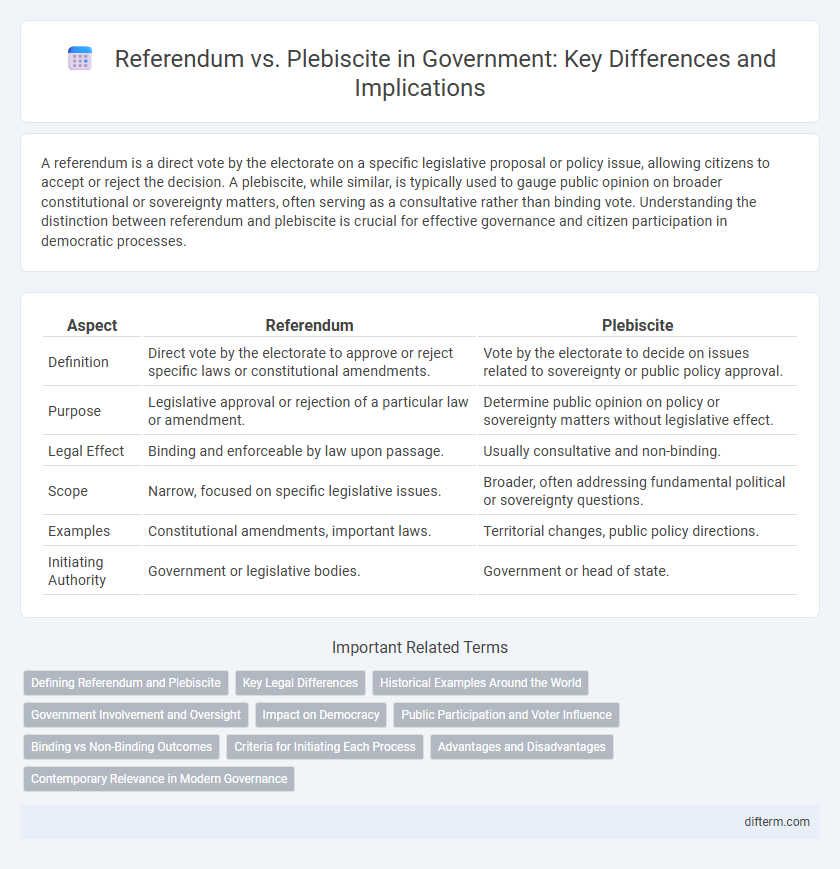A referendum is a direct vote by the electorate on a specific legislative proposal or policy issue, allowing citizens to accept or reject the decision. A plebiscite, while similar, is typically used to gauge public opinion on broader constitutional or sovereignty matters, often serving as a consultative rather than binding vote. Understanding the distinction between referendum and plebiscite is crucial for effective governance and citizen participation in democratic processes.
Table of Comparison
| Aspect | Referendum | Plebiscite |
|---|---|---|
| Definition | Direct vote by the electorate to approve or reject specific laws or constitutional amendments. | Vote by the electorate to decide on issues related to sovereignty or public policy approval. |
| Purpose | Legislative approval or rejection of a particular law or amendment. | Determine public opinion on policy or sovereignty matters without legislative effect. |
| Legal Effect | Binding and enforceable by law upon passage. | Usually consultative and non-binding. |
| Scope | Narrow, focused on specific legislative issues. | Broader, often addressing fundamental political or sovereignty questions. |
| Examples | Constitutional amendments, important laws. | Territorial changes, public policy directions. |
| Initiating Authority | Government or legislative bodies. | Government or head of state. |
Defining Referendum and Plebiscite
Referendum is a direct vote by the electorate on a specific legislative measure or constitutional amendment, allowing citizens to approve or reject proposed laws. Plebiscite, on the other hand, is a direct vote to express public opinion on important national or political issues without binding legislative consequences. Both tools serve as instruments of direct democracy but differ primarily in their legal authority and scope of decision-making.
Key Legal Differences
Referendums require electorate approval for specific constitutional amendments or laws, while plebiscites serve as advisory votes on broader governmental policies without binding legal effect. Referendums typically follow a formal legislative process with strict procedural requirements, whereas plebiscites are often initiated by the government to gauge public opinion. Legal frameworks distinguish referendum outcomes as mandatory, binding changes in law, contrasting with plebiscites which influence decisions but do not compel legislative action.
Historical Examples Around the World
The 2016 Brexit referendum in the United Kingdom is a prominent example where voters decided on EU membership, showcasing the power of direct democracy in modern governance. Similarly, the 1967 Australian referendum successfully altered the constitution to include Indigenous Australians in the census and allowed the federal government to legislate for them. Another significant plebiscite occurred in the Philippines in 1987, where citizens voted on a new constitution after the fall of the Marcos regime, illustrating the use of plebiscites in legitimizing fundamental political change.
Government Involvement and Oversight
Referendums involve direct voting by the electorate on specific legislative or constitutional issues, with government bodies typically overseeing the process to ensure legality and transparency. Plebiscites, while also a form of direct vote, are often government-initiated consultative tools without binding results, usually managed by electoral commissions or designated government agencies. Government oversight in referendums tends to be more stringent due to their binding nature, requiring strict adherence to legal frameworks and electoral standards.
Impact on Democracy
Referendums empower citizens by allowing direct voting on specific legislation, enhancing participatory democracy and fostering greater public engagement in decision-making. Plebiscites, often consultative and called by governments to gauge public opinion, may influence policy but typically lack binding authority, which can limit their democratic impact. Both tools shape democratic processes, with referendums providing a mechanism for concrete political change and plebiscites serving as instruments for measuring public sentiment.
Public Participation and Voter Influence
Referendums typically involve direct public participation by allowing voters to accept or reject specific legislative measures, providing a clear mechanism for influencing government policy. Plebiscites often serve to gauge public opinion on broader issues without binding legal effect, thus offering a less direct but still significant form of voter influence. Both instruments enhance democratic engagement but differ in legal impact and the extent to which public input shapes government decisions.
Binding vs Non-Binding Outcomes
Referendums typically produce binding outcomes that require government action based on the majority vote, directly influencing legislation or constitutional changes. Plebiscites often result in non-binding outcomes that serve as a means to gauge public opinion without mandating legal or policy changes. Understanding the distinction between binding and non-binding results is crucial for interpreting the political and legal impact of these democratic processes.
Criteria for Initiating Each Process
Referendum initiation typically requires a legislative proposal or government decision followed by a formal process, often involving signature collection or parliamentary approval. Plebiscite initiation may be driven directly by governmental authority without mandatory legislative endorsement, focusing on specific constitutional or territorial matters. Legal frameworks and criteria vary by country, emphasizing the purpose, scope, and involved authorities for each process.
Advantages and Disadvantages
Referendums provide a direct method for citizens to vote on specific legislative issues, enhancing democratic participation and legitimacy but can oversimplify complex policies and lead to majority tyranny. Plebiscites allow governments to gauge public opinion on broader policy questions or constitutional changes, facilitating political stability and decision-making but often lack binding authority and may be influenced by government bias. Both tools carry risks of misinformation campaigns and voter manipulation, requiring robust legal frameworks and public education for effective implementation.
Contemporary Relevance in Modern Governance
Referendums and plebiscites play crucial roles in modern governance by enabling direct citizen participation in decision-making on constitutional amendments, policy reforms, and local governance issues. Referendums often have binding outcomes, requiring governments to implement the results, while plebiscites typically serve as advisory tools to gauge public opinion on specific matters. Their contemporary relevance is evident in democratic societies seeking to enhance legitimacy, transparency, and public engagement in complex political decisions.
referendum vs plebiscite Infographic

 difterm.com
difterm.com